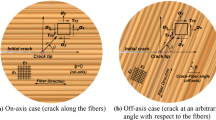Abstract
This paper is dedicated to the study of the effect of moisture content on fracture properties of wood through the corresponding effect on the softening function used in cohesive zone model to describe quasi-brittle failure of wood. Bi-linear softening parameters of cohesive zone model are estimated from equivalent linear elastic fracture mechanics resistance curve obtained from a significant number of fracture tests performed in mode I for a wide range of moisture contents (from 5 to \(30\%\) moisture). The evolution of the cohesive zone parameters as a function of the moisture exhibits a moisture dependence of the fracture properties of wood and especially the increase of the cohesive energy related to the crack-bridging phenomenon.











Similar content being viewed by others
References
Bažant ZP, Planas J (1998) Fracture and size effect in concrete and other quasibrittle materials. CRC Press, Boca Raton
Boström L (1992) Method for determination of the softening behaviour of wood and the applicability of a nonlinear fracture mechanics model. PhD thesis, University of Lund
Coureau JL, Morel S, Gustafsson PJ, Lespine C (2006) Influence of the fracture softening behaviour of wood on load-COD curve and R-curve. Mater Struct 40(1):97–106
Coureau JL, Morel S, Dourado N (2013) Cohesive zone model and quasibrittle failure of wood: a new light on the adapted specimen geometries for fracture tests. Eng Fract Mech 109:328–340
de Moura M, Morais J, Dourado N (2008) A new data reduction scheme for mode I wood fracture characterization using the double cantilever beam test. Eng Fract Mech 75(13):3852–3865
Dourado N (2008) R-Curve behaviour and size effect of a quasibrittle material: wood. PhD thesis, Universite de Bordeaux I
Dourado N, Morel S, de Moura M, Valentin G, Morais J (2008) Comparison of fracture properties of two wood species through cohesive crack simulations. Compos Part A Appl Sci Manuf 39(2):415–427
Dourado N, de Moura M, Morais J, Silva M (2010) Estimate of resistance-curve in wood through the double cantilever beam test. Holzforschung 64(1):119–126
Guitard D (1987) Mécanique matériau bois et composites (Mechanics of wood and composites materials). Cepadues Editions, France
Lamy F, Takarli M, Angellier N, Dubois F, Pop O (2015) Acoustic emission technique for fracture analysis in wood materials. Int J Fract Mech 192:57–70
Morel S, Dourado N, Valentin G, Morais J (2005) Wood: a quasibrittle material R-curve behavior and peak load evaluation. Int J Fract 131(4):385–400
Morel S, Coureau JL, Planas J, Dourado N (2010) Bilinear softening parameters and equivalent LEFM R-curve in quasibrittle failure. Int J Solids Struct 47(6):837–850
Phan NA (2016) Simulation of time-dependent crack propagation in a quasi-brittle material under relative humidity variations based on cohesive zone approach : application to wood. PhD thesis, University of Bordeaux
Prokopski G (1996) Influence of moisture content on fracture toughness of wood. Int J Fract 79(4):R73–R77
Reiterer A, Stanzl-Tschegg SE (2002) The influence of moisture content on the mode I fracture behaviour of sprucewood. J Mater Sci 37:4487–4491
Vasic S, Stanzl-Tschegg SE (2007) Experimental and numerical investigation of wood fracture mechanisms at different humidity levels. Holzforschung 61(4):367–374
Xavier J, Monteiro P, Morais J, Dourado N, de Moura M (2014a) Moisture content effect on the fracture characterisation of Pinus pinaster under mode I. J Mater Sci 49(21):7371–7381
Xavier J, Oliveira M, Monteiro P, Morais J, de Moura M (2014b) Direct Evaluation of Cohesive Law in Mode I of Pinus pinaster by Digital Image Correlation. Exp Mech 54:829–840
Acknowledgements
The authors thank the French National Research Agency (ANR) for supporting the study through the Xyloplate project, Equipex XYLOFOREST (ANR-10-EQPX-16). This work is also supported by the Regional Council of Aquitaine and by the CODIFAB. Computational aspects of the study were performed at MCIA (Mésocentre de Calcul Intensif Aquitain) of the Université de Bordeaux and of the Université de Pau et des Pays de l’Adour.
Author information
Authors and Affiliations
Corresponding author
Rights and permissions
About this article
Cite this article
Phan, N.A., Chaplain, M., Morel, S. et al. Influence of moisture content on mode I fracture process of Pinus pinaster: evolution of micro-cracking and crack-bridging energies highlighted by bilinear softening in cohesive zone model. Wood Sci Technol 51, 1051–1066 (2017). https://doi.org/10.1007/s00226-017-0907-8
Received:
Published:
Issue Date:
DOI: https://doi.org/10.1007/s00226-017-0907-8




